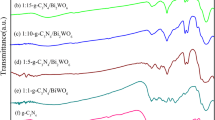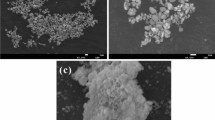Abstract
To utilize visible light more efficiently in photocatalytic reactions, Bi2O3/CaO photocatalysts were prepared by a mechanical mixing method and characterized by X-ray diffraction (XRD) and UV–vis spectroscopy. UV–vis spectroscopy results showed that the photocatalysts have a wide absorption band in the range of visible light. The photocatalytic activities of obtained Bi2O3, CaO, and Bi2O3/CaO samples were evaluated by methylene blue degradation under visible light irradiation. It was found that the Bi2O3/CaO sample exhibited the highest photocatalytic activity.
Similar content being viewed by others
Avoid common mistakes on your manuscript.
Introduction
In recent years, a large number of investigations have focused on semiconductor-based photocatalysts because of their wide applications in solar energy conversion and environmental purification [1–9]. Photocatalytic degradation has proven to be a promising technology for the removal of various organic pollutants in wastewater for its many attractive advantages, including the environmental friendly feature, relatively low cost and little energy consumption. However, the fast recombination rate of the photogenerated electron/hole pairs hinders the commercialization of this technology [10]. Among various semiconductors employed, Bi2O3 is known to be a good photocatalyst for the degradation of several environmental contaminants [10–15] due to its high photosensitivity, which means high driving force for the reduction and oxidation processes. For the more efficient utilization of Bi2O3, efforts have been made to combine Bi2O3 with other semiconductors having different band energies since the coupling of two semiconductor particles with different energy levels is useful to achieve effective charge separation [11–13]. In this report, a novel Bi2O3/CaO photocatalyst was investigated, which is highly active in the photocatalytic oxidative decomposition of MB under visible light irradiation.
Experimental
Synthesis and characterization of Bi2O3/CaO photocatalysts
The Bi2O3/CaO photocatalyst was synthesized by a simple precipitation–calcination-mixture method. Aqueous solutions of Ca(NO3)2·4H2O or Bi(NO3)2·6H2O and NaOH were mixed together in 1:3 molar ratio under stirring. The mixtures were stirred for 20 min at room temperature. Afterwards, the precipitates formed were centrifuged, washed with de-ionized water, and dried at 373 K in air for 3 h. The obtained powder was calcined at 800 °C for 6 h to produce crystalline materials. Finally, Bi2O3 and CaO prepared separately were mechanically mixed in a fixed molar ratio to obtain the Bi2O3/CaO photocatalysts.
Characterization
X-ray diffraction (XRD) patterns of the samples were taken on a Rigaku D/max 2500 powder diffractometer by using Cu K α radiation with the wavelength of 1.5406 Å and recorded from 3° to 80° (2θ). UV–vis absorption spectra were recorded in the range of 240–800 nm on a HP8453 UV–vis spectrometer. The BET surface areas (SBET) were measured by N2 adsorption at −196 °C using an automatic surface area and pore size analyzer (Autosorb-1-MP 1530VP). SBET measurements were performed using the five-point BET method.
Photocatalytic decomposition of methylene blue
The photocatalytic activity under visible light irradiation of the Bi2O3/CaO samples was evaluated by using methylene blue (MB) as the model substrate. 250 mL MB (10 mg/L) aqueous solution and 1.0 g of photocatalyst powder were mixed in a quartz photoreactor. Prior to a photocatalytic reaction, the photocatalyst suspension was sonicated to reach adsorption equilibrium with the photocatalyst in the dark. The above solution was photoirradiated by using a 300 W Xe lamp as light source under continuous stirring. A cut-off filter was used in these experiments (λ > 400 nm). At a defined time interval, the concentration of MB in the photocatalytic reaction was analyzed by using an UV–vis spectrophotometer at 665 nm.
Results and discussion
The powder XRD patterns of the Bi2O3, CaO, and Bi2O3/CaO samples treated at 800 °C are shown in Fig. 1. From the corresponding characteristic 2θ values of the diffraction peaks in Fig. 1a and b, it can be confirmed that the as-prepared Bi2O3 sample is identified as monoclinic phase (ICDD PDF 14-0699), while the CaO is cubic phase (ICDD PDF 82-1691). Fig. 1c shows the XRD patterns of the Bi2O3/CaO sample obtained by mechanically mixing alone Bi2O3 and CaO calcined at 800 °C. From Fig. 1c, all the diffraction lines are a nice match for the XRD patterns of alone Bi2O3 and CaO. It can be observed that there are no impurities other than the phase of Bi2O3 and CaO in Fig. 1c. The average crystallite size of the CaO and Bi2O3 components of the Bi2O3/CaO samples was calculated using the Debye–Scherrer equation:
where D is the average crystallite size in angstroms, λ is the wavelength of the X-ray radiation (Cu K α, 0.1548 nm), β is the full width at half-maximum, and θ is the diffraction angle. The calculated results are 28 and 21 nm for the CaO and Bi2O3 components, respectively.
Fig. 2 presents UV–vis absorption spectra of the Bi2O3, CaO, and Bi2O3/CaO samples calcified at 800 °C. The as-prepared CaO sample exhibits no obvious optical properties concerning the absorption in the visible light range, which is different from the Bi2O3 sample. The Bi2O3 sample has a wide absorption band in the range of 400–500 nm. For the Bi2O3/CaO sample, there exists a wide absorption band in the visible light range, which shows that the photocatalyst can exhibit the higher visible light activity.
The photocatalytic activity of the prepared samples was determined by the degradation of 10 mg/L MB aqueous solutions under visible light irradiation. MB shows a maximum absorption at about 665 nm. Total concentrations of MB were simply determined by the maximum absorption measurement. The specific surface area of the Bi2O3, CaO, Bi2O3/CaO, and P25 samples is 12, 39, 27, 45 m2 g−1, in order. (The mole ratio of Bi/Ca is 0.25.)
The decrease of the concentration of MB in aqueous solution after 9.5 h under visible light irradiation in the presence of the Bi2O3, CaO and Bi2O3/CaO samples calcined at 800 °C is shown in Fig. 3. From Fig. 3a, the MB photolysis without photocatalysts only produces about 10% decomposition of MB molecules, which can be accounted for the photosensitized capability of MB molecules. Under the same reaction conditions, the P25, CaO and Bi2O3 samples exhibit a low visible light photocatalytic activity for aqueous MB degradation. Their photodegradation efficiency is about 32.8, 16.7 and 53.8% (Fig. 3b–d). The photodegradation efficiency of the Bi2O3/CaO sample has achieved 94.2% (Fig. 3e). However, the adsorption capacity of MB into Bi2O3/CaO is very small in dark (Fig. 3f). In comparison with the separate Bi2O3 and CaO samples, the sample has the highest photocatalytic activity toward the MB degradation.
The spectral changes during the photodegradation of MB mediated by the typical Bi2O3/CaO sample (800 °C, 6 h) under visible light irradiation are displayed in Fig. 4. In Fig. 4, there are two main absorbance peaks at about 290 and 665 nm before the photocatalytic reaction, which are attributed to the absorbance of the phenyl ring and the chromophore. During the photodegradation process, the two major absorption bands gradually shifted to about 280 and 590 nm, and the intensities of the two absorbance peaks decreased gradually with temporal evolution, which may imply the destruction of the MB structure over the Bi2O3/CaO sample.
To investigate the reusability of the Bi2O3/CaO photocatalyst, the Bi2O3/CaO photocatalyst was repeatedly used 5 times under the same experimental conditions. Fig. 5 shows the reusability results. According to Fig. 5, it is clear that the concentration of MB in the photocatalytic reaction gradually increases with increasing reuse times. The photocatalytic activity of Bi2O3/CaO in the fifths experiment decreases by only 78%. XRD analysis of the solid material remaining after five reaction cycles revealed that (BiO)2CO3 has been produced (Fig. 6). The result is the same as in an earlier reference [16]. The slight structural change may be a main reason for the decrease in the photocatalytic activity of Bi2O3/CaO.
It is inferred that the higher activity of Bi2O3/CaO may be attributed to the formation of heterojunctions on its surface in references [17, 18]. The electrons in the valence band (VB) of Bi2O3 can be excited to the conduction band (CB) with visible light irradiation because Bi2O3 has high absorption over the visible light range of 400–500 nm. Therefore, many vacant holes are rendered in the VB of Bi2O3, at the same time, the electrons in the VB of CaO can be transferred to that of Bi2O3, which results in an effective separation of photogenerated electrons as well as holes, and the holes in the VB of CaO can generate the photocatalytic oxidation reactions. Thus, the Bi2O3/CaO photocatalyst can effectively degrade MB by absorbing the visible light.
In summary, Bi2O3/CaO photocatalysts were prepared and the photocatalytic activity of as-prepared samples was evaluated. The electron transfer occurring inside the Bi2O3/CaO photocatalysts was demonstrated by performing the photocatalytic decomposition of MB under visible light irradiation. The photocatalysts exhibited higher photocatalytic activity towards MB degradation than pure P25, CaO and Bi2O3 under visible light irradiation.
References
Fujishima A, Honda K (1972) Nature 37:238
Asahi R, Morikawa T, Ohwaki T, Aoki K, Taga Y (2001) Science 293:269
Fu XX, Yang QH, Wang JZ (2003) J Rare Earth 21:424
Miyauchi M, Takashio M, Tobimatsu H (2004) Langmuir 20:232
Nosaka Y, Matsushita M, Nishino J, Nosaka AY (2005) Sci Technol Adv Mater 6:143
Irie H, Washizuka S, Hashimoto K (2006) Thin Solid Films 510:21
Zeng J, Wang H (2007) J Phys Chem C 111:11879
Liu JW, Chen G, Zhang ZG (2007) J. Hydrog Energy 32:2269
Compton OC, Carroll EC (2007) J Phys Chem C 111:14589
Hoffmann MR, Martin ST, Choi W, Bahnemann DW (1995) Chem Rev 95:69
Bessekhouad Y, Robert D, Weber JV (2005) Catal Today 101:315
Zhang LH, Wang WZ, Yang J, Chen ZG, Zhang WQ, Zhou L, Liu SW (2006) Appl Catal A: Gen 308:105
Karunakaran C, Dhanalakshmi R (2008) Sol Energy Mater Sol Cells 92:588
Chen XY, Zhang ZJ, Lee SW (2008) J Solid State Chem 181:166
Hameed A, Montini T, Gombac V, Fornasiero P (2008) J Am Chem Soc 130:9658
Eberl J, Kisch H (2008) Photochem Photobiol Sci 7:1400
Chai SY, Kim YJ, Jung MH, Chakraborty AK, Jung DW, Lee WI (2009) J Catal 262:144
Gao BF, Kim YJ, Chakraborty AK, Lee WI (2008) Appl Catal B: Environ 83:202
Acknowledgment
This work was supported by Development Program of Science and Technology of Tianjin (06TXTJJC14400).
Open Access
This article is distributed under the terms of the Creative Commons Attribution Noncommercial License which permits any noncommercial use, distribution, and reproduction in any medium, provided the original author(s) and source are credited.
Author information
Authors and Affiliations
Corresponding author
Rights and permissions
Open Access This is an open access article distributed under the terms of the Creative Commons Attribution Noncommercial License (https://creativecommons.org/licenses/by-nc/2.0), which permits any noncommercial use, distribution, and reproduction in any medium, provided the original author(s) and source are credited.
About this article
Cite this article
Song, L., Zhang, S. Preparation and visible light photocatalytic activity of Bi2O3/CaO photocatalysts. Reac Kinet Mech Cat 99, 235–241 (2010). https://doi.org/10.1007/s11144-009-0130-1
Received:
Accepted:
Published:
Issue Date:
DOI: https://doi.org/10.1007/s11144-009-0130-1










